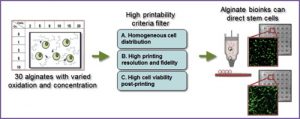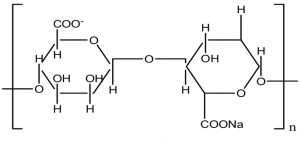Alginate is derived from brown algae
Alginate is a polysaccharide distributed widely in cell walls of brown algae. When it bonds with water it typically forms a viscous gum. Alginate absorbs water quickly, which makes it useful as an additive. Alginate can be used as a hydrogel as well. It has very interesting applications. It is a hydrogel consisting of microparticles or in bulk gels combined with nerve growth factor in bioengineering research. It has been used as scaffolding for tissue engineering, as a delivery vehicle for drugs, and as model extracellular matrices for basic biological studies. These applications require tight control of a number of material properties including mechanical stiffness, swelling, degradation, cell attachment, and binding or release of bioactive molecules.
The chemical structure of alginate is composed of two types of uronic acid: Mannuronic acid unit (M) and Guluronic acid unit (G). Differences in M/G ratio and block configuration account for the differences in alginate properties and functionality, especially in gelling capability and gel strength. The M/G ratio is dependent upon such factors as is the species of seaweed (imagine the difference of a species found near water around remote East Asian Islands vs. seaweed found in a nice tropical location near the Bahamas), the part of the seaweed used, the harvest location, and the harvesting season. The carboxyl groups within the M and G units are easily ion-exchanged, and can react with several kinds of cations. Cations are essential to consider when it comes to material strength.
Alginates have been used as scaffolds for tissue engineering extensively. We have discussed hydrogels previously within this series, but what makes an alginate different? Alginate based products possess excellent shear-thinning properties, and can be easily extruded through a nozzle. There they also have good initial shape fidelity. Alginate is widely used for most bioprinting extrusion processes due in part to this. There is also a focus on alginate due to the ability to mix materials readily with these extrusion methods. Alginate is biodegradable, has controllable porosity, and may be linked to other biologically active molecules. Encapsulation of certain cell types into alginate beads may actually enhance cell survival and growth. Outside of biodegradability, alginates are also non-toxic. This is vital for biomedical purposes.
Sodium Alginate Chemical Structure
Alginate is a great biomaterial. As with the other biomaterials we have analyzed, it is typically used in combination with other materials. This is related to what we previously mentioned in this article in terms of bioreactivity. It allows a material scientist or engineer to experiment and make substances with various tensile strengths and viscosity levels. With the benefits of alginate, there come some major cons. The most important thing to consider is how much water a hydrogel derived from alginate can contain. Depending on the hydrophilicity, a hydrogel from alginate may not be able to maintain absorbance levels for larger scale builds. This is why we cannot make a bioink or hydrogel from solely alginate. Stay tuned for info on more materials used within bioprinting. This field has such variety within it, so we will do our best to shed a light on important materials and processes.
This article is part of a series that ultimately wants to update 3DPrint.com readers in the most vital and relevant information in bioprinting. We hope that this will prompt people to bioprint at home which in turn may accelerate the bioprinting revolution. Essentially, this article has as its goal to kickstart a DIY bioprinting revolution. Please spread the word. The first article Bioprinting 101 is here, while Part Two Hydrogels is here and part three Industrial printers is here.
Subscribe to Our Email Newsletter
Stay up-to-date on all the latest news from the 3D printing industry and receive information and offers from third party vendors.
Print Services
Upload your 3D Models and get them printed quickly and efficiently.
You May Also Like
Consolidation in AM: How 2025 Is Shaping the Industry’s New Normal
The first half of 2025 has been marked by a clear shift in the additive manufacturing (AM) industry. Companies are no longer just focused on developing new tech by themselves....
Etsy Design Rule Change Reduces Selection of 3D Printed Goods
Online marketplace Etsy has implemented a rule change requiring all 3D printed goods on the site to be original designs. The update to the site’s Creativity Standards states, ¨Items produced using...
U.S. Congress Calls Out 3D Printing in Proposal for Commercial Reserve Manufacturing Network
Last week, the U.S. House of Representatives’ Appropriations Committee moved the FY 2026 defense bill forward to the House floor. Included in the legislation is a $131 million proposal for...
Transforming From Tourist to Native: Duro CEO Michael Corr Explains Why the Company Rebuilt its PLM Software on AI
In these early innings of the AI boom, many market analysts have expressed concern that AI spend has gotten too far ahead of the technology’s proven ability to deliver significant...



































